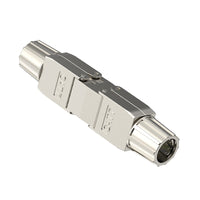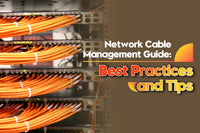Contents
In the world of both personal comfort and electronic circuits, the presence of “noise” can be quite unsettling. This interference, often referred to as electrical noise, is the unwanted and disruptive interference in electrical signals. It poses a significant challenge in low-voltage circuits, for example, it can cause frustrating problems like poor data transmission.
If you’re unaware of the electrical noise, you’ve come to the right place. This article delves into the topic of how to reduce electrical noise for a stable and reliable network.
What is Electrical Noise?
Electrical noise is unwanted signals resulting from more or less random or systematic electrical signals that appear in electrical circuits. Data and signal circuits, operating at relatively low voltage levels while delivering high-speed performance, are particularly susceptible to electrical noise. The lower the voltage, the more vulnerable the circuit will suffer from noise. Electrical noise will make voltage fluctuate and affect data transmission.
There are four common noise coupling types, and they are a bit complicated, so we’ll explain them in a simple way.
- Conductive Coupling: Conductive coupling occurs when the noise is coupled by a direct connection. This can happen when wires are too close to each other on a PCB, or they share the same ground or conductors.
- Inductive Coupling:It is known that every conductor with current flow has a magnetic field around it. So, the current flow in one conductor can induce a voltage in an adjacent conductor, which can also be a source of interference.
- Capacitive Coupling: Capacitive coupling usually refers to electrostatic noise caused by the electric field between two conductors. The capacitance exists in any circuit, and the higher the frequency, the greater the potential of capacitive coupling.
- Radiative Coupling: Radiative coupling, also known as electromagnetic interference (EMI) or radio-frequency interference (RFI), usually happens when the noise and victim are a little bit far away from each other. It occurs when electromagnetic waves generated by one circuit travel through the air and induce voltage in another circuit. The equipment near many electronic devices will be affected by electromagnetic fields.
Effect of the Electrical Noise
Electrical noise can negatively impact the quality and reliability of electrical signals and data transmission. One of the common effects of the electrical noise is reduced signal quality, making it difficult to distinguish the interference signals. Additionally, electrical noise can also cause slower data transfer rates, increased packet loss, network latency and reduced efficiency. Furthermore, it complicates the process of troubleshooting network problems, making it a more arduous task.
5 Ways to Reduce Electrical Noise
Though noise can never be eliminated, some methods can be adopted to lessen electrical noise. How to effectively mitigate the effect of electrical noise for a stable network transmission? Here are some useful methods.
Use Shielded Cables
Some people may wonder if the cable jacket can help reduce electrical noise. The answer is that a cable jacket can protect the cable from corrosion and abrasion, but it cannot help mitigate noise.
Network cables can be classified into shielded and unshielded types. Shielded Ethernet cables are designed with an additional layer of shielding material, typically metal. The shielding wraps around the inner conductor and acts as a barrier to electromagnetic interference (EMI) and radio frequency interference (RFI). Shielded cables are particularly suitable for environments with high levels of electronic equipment.

Use Twisted Pair Cables
Why are Ethernet cables twisted inside? You’ll find the answer here. The primary function of twists is to reduce interference. Every wire conductor has an unequal electromagnetic field, meaning that a single conductor can affect another. You know that Ethernet cables have eight copper wires, and this will cause cross-talk. Cross-talk occurs when signals on one pair of wires induce unwanted signals in adjacent pairs. The twisting design helps move some noise in the direction of the signal and some in the opposite direction, which can effectively cancel out differences in each conductor’s individual electromagnetic fields. Overall, the twisted pair is essential to Ethernet cable to ensure reliable and noise-resistant data transmission in various network environments.

Proper Cable Route
Establishing a proper cable route is crucial for minimizing electrical noise in your network. Here’s how you can achieve this:
- Use cable trays, racks, and conduits to organize cables
- Keep Ethernet cables as straight as possible during cable installation
- Separating low-voltage and high-voltage cables, e.g. , separating power and data cables in different conduits or cable trays
- Keep cable lengths within the maximum limit to avoid signal degradation and noise

Proper Grounding
Proper grounding is essential not only for reducing electrical noise but also for safety and security. Remember to connect wires to the ground and make contact with the shielding on another end so the unwanted electrical signals or other interference can flow safely into the ground.
Bonding and grounding all metal structures can ensure all circuits within the system take the earth’s voltage as the reference, and different signals and voltages can be adjusted according to this reference.
Moreover, proper grounding helps protect against power surges and lightning strikes by providing a safe path for excess voltage to dissipate into the ground. So, proper grounding can also help protect your electrical equipment.
Noise Sources Isolation and Regular Maintenance
Identify and isolate potential noise sources such as fluorescent lights, motors, or other electronic devices. Use different systems to place data acquisition systems and noisy devices separately. In addition, regular maintenance and inspection of your network infrastructure is also very necessary so that you can replace damaged cables and connectors to prevent noise issues.
Final Words
Electrical noise can not be seen, but it actually exists here and there. It will have an increase in the future because of the larger use of various wireless devices and other electrical equipment.
Now that you’re aware of the effect of electrical noise and know some effective methods to reduce it, you may need more attention to the cabling system plan and measurement. Different situations require varying combinations of methods.
Most electrical noise can only be minimized, but keeping it at a minimized level is of great benefit to your network stability, speed, and safety.
For more information on this topic, you can keep up on our blogs. While VCELINK offers general and basic information for our customers and other visitors to the website, it’s not professional advice.






Be the first one to comment.
Leave a comment